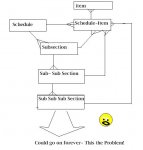CadMonkey
Misplaced But Useful
- Local time
- Today, 15:29
- Joined
- May 19, 2004
- Messages
- 47
Hi,
Mucho gracias if you pros can help me! I've only completed 1 year of a degree...
I have a many to many table relationship that I have resolved with another table- therefore I now have two one to many relationships, fairly standard stuff. Basically I need to list items under a schedule. So currently the tables may be like this:
1 Schedule record can have many item records.
This is no problem but the schedule MAY be split up into various sections. E.g.
1 Schedule record can have many sections.
1 Section can have many items.
Okay but what if I want to store items either under a section or straight under the schedule?
1 Schedule record can have many sections.
1 Schedule can have many items.
1 Section can have many items. (Easy way out have a section that's PK'd to represent the Schedule)
Now the tricky bit.. where I need help really from a pro dude/dudess.
Can I have a set of relationships where the user can create sections and sub sections of those sections all within a schedule, and can then store items under the sechule itself, under a section, under a subsection of a section, under a subection of a subsection of a section? I.e. infinite nests? Sounds crazy- maybe it is. But this is a real life situ!
Many thanks,
Simon
Mucho gracias if you pros can help me! I've only completed 1 year of a degree...
I have a many to many table relationship that I have resolved with another table- therefore I now have two one to many relationships, fairly standard stuff. Basically I need to list items under a schedule. So currently the tables may be like this:
1 Schedule record can have many item records.
This is no problem but the schedule MAY be split up into various sections. E.g.
1 Schedule record can have many sections.
1 Section can have many items.
Okay but what if I want to store items either under a section or straight under the schedule?
1 Schedule record can have many sections.
1 Schedule can have many items.
1 Section can have many items. (Easy way out have a section that's PK'd to represent the Schedule)
Now the tricky bit.. where I need help really from a pro dude/dudess.
Can I have a set of relationships where the user can create sections and sub sections of those sections all within a schedule, and can then store items under the sechule itself, under a section, under a subsection of a section, under a subection of a subsection of a section? I.e. infinite nests? Sounds crazy- maybe it is. But this is a real life situ!
Many thanks,
Simon

